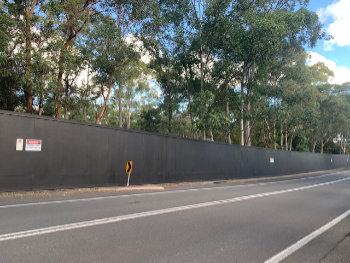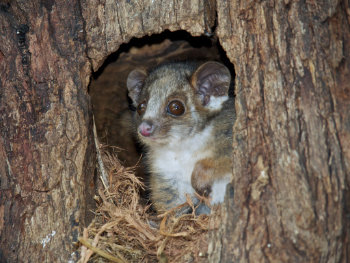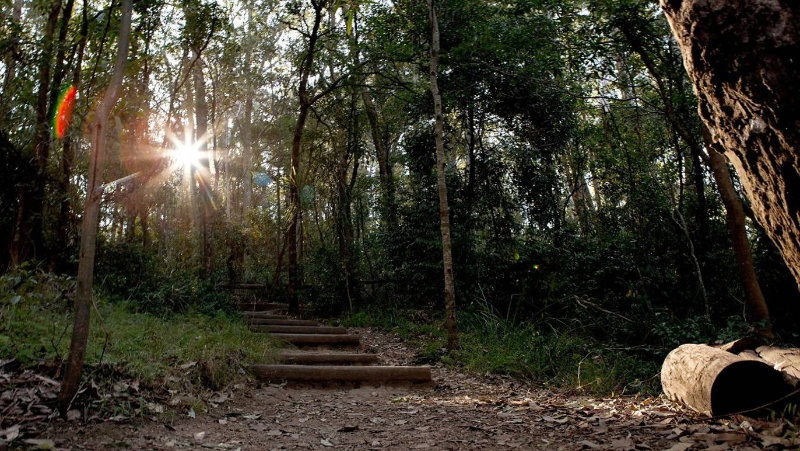It was shovels at the ready as Australia plotted recovery from the economic ravages wrought by the pandemic. Buildings, roads, ports, dams. But hasty decision making is leading to long-term regrets among some affected communities. Kurt Johnson hones in on one example.
Demolition of office buildings and the clearing of 1253 trees has begun for a 418-home “family friendly community” in Sydney’s West Pennant Hills. A black wall more than two metres high has been erected right up to the kerb. It blocks neighbours from monitoring the impact on wildlife but they can hear the earthmovers. It sounds like “a rumbling … like thunder” says one resident. In a concession to complaints, developer Mirvac has agreed to paint the wall a light green to be more visible to passing traffic.
 Developer Mirvac describes this project as one “that sensitively responds to the natural landscape”. But the $236 million development adds to the emerging narrative that projects being promoted as part of the post-Covid recovery are overriding communities and councils – environmental safeguards.
Developer Mirvac describes this project as one “that sensitively responds to the natural landscape”. But the $236 million development adds to the emerging narrative that projects being promoted as part of the post-Covid recovery are overriding communities and councils – environmental safeguards.
What’s more, the site, at 55 Coonara Avenue, is also being scrutinised as a key example of developers ‘‘sidestepping’’ NSW legislation intended to protect native wildlife.
In 2019 the proposal to rezone the defunct IBM office complex for residential development was rejected by Hills Council. The community had hoped it would be turned into a park. Then in June 2020, the state government’s Planning System Acceleration Program, tasked with fast-tracking projects that “are shovel-ready, and that provide a public benefit”, pushed through the rezoning.
When it became clear the development may go ahead, Hills Council received 4000 letters of objection with the community holding a ‘Vigil for the Forest’. It drew a broadside of political opposition at multiple levels, with state Labor and the Animal Justice Party together with Greens and Liberal members of the Hills Shire Council. The newly elected Mayor, Dr Peter Gangemi, said “councillors have been sidelined…”
Much of the opposition focuses on the conservation value of the site which adjoins the Cumberland State Forest, an island of endangered bush and protected wildlife within a booming residential area. Former owner IBM had worked with the National Trust to regenerate the bush. Today both the site and state forest remain under ‘Priority Management’ through the NSW Saving our Species Scheme with a status of “Critically Endangered Ecological Community” although it’s not clear what protection this brings.
Initial concern was for the Blue Gum High and Sydney Turpentine Ironbark forests both critically endangered in NSW. Following an arborist’s report revealing blue gum trees within the demolition area, Mirvac referred the decision to the then federal Environment Minister Sussan Ley in July last year. Ley approved the trees’ removal in September.
Attention has since shifted from flora to fauna. Documents obtained by Michael West Media reveal that numerous animals were discovered during pre-clearance surveys, including evidence of protected species such as the ‘‘vulnerable’’ fishing bat southern myotis, the endangered Dural land snail as well as microbats, echidnas, frogs, possums, geckos and skinks. Powerful owls, the largest owl in Australasia, classed as vulnerable in NSW, have been a particular point of contention. On March 31, one was captured on an infrared camera at the eastern edge of the site. This runs contrary to claims by Mirvac development director Adrian Checchin, who stated at an early planning meeting there were “no Powerful Owls.” “We have been monitoring them for years and haven’t seen them on our site.”
A Mirvac spokesperson told MWM: “Mirvac has undertaken a wide range of initiatives to protect, restore and enhance the flora and fauna at Coonara Avenue. All fauna related activities on site are undertaken in strict accordance with the relevant consent conditions and the Fauna Management Plan, which has been endorsed by The Hills Shire Council.”
Managing animals to their deaths
 A Fauna Management Plan (FMP) is a non-standard document that details how a site should be surveyed for wildlife and how discovered wildlife should be managed. This process is coming under scrutiny as the legislation allows developers to “sidestep” the strict standards and laws that apply elsewhere, to animal handlers, vets and the public.
A Fauna Management Plan (FMP) is a non-standard document that details how a site should be surveyed for wildlife and how discovered wildlife should be managed. This process is coming under scrutiny as the legislation allows developers to “sidestep” the strict standards and laws that apply elsewhere, to animal handlers, vets and the public.
“The legislation is failing,” says Licensed Wildlife Rescuer Katrina Emmett, a vocal opponent of the development, “There is no requirement for the Fauna Management Plan to be consistent with the animal welfare standards.”
Mirvac employed Cumberland Ecology to produce the FMP for the demolition. An early copy released in November 2021 came under criticism with feedback being incorporated in the final version in January. The director of Cumberland Ecology, Dr David Robertson, has stated “Once a project is approved the management plan is written to a specification that embraces those original ethical approval standards.”
Yet according to animal carers such as Emmett, the final version still has multiple shortcomings. “The FMP has a lot of missing animal protocols for native wildlife that live there like echidnas and gliders and even some protected species like pygmy possums.”
Problems were also noted regarding the release of discovered fauna into the adjoining bush, particularly for species that are territorial. Emmett states: “If anything, it may just be leaving them to suffer a slow demise through lack of available food, or being displaced from their family groups, or being released into an area with a too high density of the same species, or being released at the wrong time of year.” She notes that in winter some animals such as reptiles are hibernating.
Shaking the trees
Animal carers also dispute the effectiveness of some protocols such as: “Trees will be gently shaken by machinery prior to clearing to encourage any animals remaining to leave”. Yet of the entire Fauna Management Plan, it is the Euthanasia Protocol that provokes the greatest consternation. It includes a provision that allows injured wildlife to be euthanised if “deemed unlikely to survive travelling to the vet”.
Wildlife veterinarian Gabbi Tobias states that ecologists “shouldn’t make an assessment of the animal’s health.” The FMP includes “six vet clinics and two of them are open 24 hours and so there’s absolutely no reason for an ecologist to euthanise anything.” The closest, West Pennant Hills Veterinary Hospital is just 800 metres away. “There just seems to be this huge exemption for development compared to the rest of the people in NSW,” Tobias says.
Euthanising injured fauna has particularly strict processes in NSW. For example, the NSW Code of Practice for Injured, Sick and Orphaned Protected Fauna states: “Rescuers must arrange for fauna to be assessed by a veterinarian or experienced fauna rehabilitator within 24 hours of rescue to ensure accurate diagnosis.”
Cumberland Ecology’s David Robertson responds: “Our ecologists are scientifically trained biologists and environmental scientists and always seek veterinary support and assessment if animals are unwell or injured. Injury response is guided by a vet.”
Yet the Fauna Management Plan makes no mention of consulting a vet prior to bringing an injured animal in. Instead the plan states: “A judgement is required on injured animals as to whether they are suitable for release, transport to a vet or euthanised onsite in accordance with protocols of animal ethics approval that authorise the ecologist to perform this action if required.”
Whacking wildlife: the case for the offence
The difference between strict official protocols required of animal carers and the general public versus those within the Fauna Management Plan reveals the underlying bureaucratic blind spot that developers can exploit. This takes advantage of a complex tapestry of NSW and Commonwealth Laws but one section (2.8(1)(a)) of the Biodiversity Conservation Act provides a special defence for development approvals.
Tara Ward, the managing solicitor of the Animal Defenders Office, explains the legislation:
“Development applications in NSW may be exempt from the Biodiversity Conservation Act 2016 (BCA). Once approved by a government body – usually a local council – an action while demolishing, land clearing or construction that would be considered an offence under the BCA with regards to how wildlife is handled may be defensible by this exemption if the alleged offender can prove that the action was necessary for the carrying out of development in accordance with the relevant development consent.”
The caveat is that “Prevention of Cruelty to Animals Act 1979 (NSW) still applies to approved developments” but “it is the BCA rather than the [1979 act] that contains provisions for handling and researching native wildlife and protected ecosystems…” Ward sums this as “the exemption in the BCA for development applications could allow developers to essentially sidestep biodiversity conservation legislation intended to secure the safety of protected species.”
Also, fundamental questions surround Fauna Management Plans regarding enforcement and oversight. “Ecologists are not required to write policy when preparing management plans,” states the president of the Ecological Consultants Association of NSW, Rebecca Hogan. “It is ultimately the determining authority who will approve any [fauna] management plan.” Yet the plans stand-in for official, legally enforceable guidelines. Ward again: “If a development consent condition required compliance with a Fauna Management Plan for that particular project, non-compliance with the FMP may still be an offence under the BCA.”
Fauna Management Plans such as Cumberland Ecology’s do not reflect this in their language. Many of the stipulations are ‘‘shoulds’’ interpreted as recommendations or guidelines rather than ‘‘musts’’, mandatory standards more likely to be enforced. There is also the outstanding question: does the local council have the expertise to evaluate an FMP? Hills Council responded in an email to a complaint by Emmett that: “The onus is on these ecologists to provide the appropriate level of supervision and reporting.”
Hogan states “There is no formal template for such plans as the documents have various purposes and are site-specific.” Yet a set of minimum standards for a Fauna Management Plans could ensure a common framework for evaluation.
Box-ticking exercises
Some politicians are advocating in this direction. In June, Greens MP Cate Faehrmann brought a motion to NSW Parliament citing the Mirvac development specifically and trying to mandate Fauna Management Plans for all developments to align them with Biodiversity Conservation Act 2016.
“Developers have access to a loophole that means they aren’t required to comply with those minimum standards,” says Faehrmann. “It’s nothing more than a box-ticking exercise that gives developers a get-out-of-jail-free card to do things however they like.” The motion was blocked.
As flawed a model as it is, a Fauna Management Plan is not a requirement of all developments that could interact with protected wildlife, rather it came at the insistence of The Hills Shire Council. Subsequent development approvals for the site, such as those required to construct the new residences do not require an FMP. In these cases wildlife interactions are deferred to the DA itself which require far less rigour.
Despite all the preclearance surveys it will never be known exactly what the impact of this development and those like it will have on animals, Tobias, Emmett and other wildlife carers we spoke with agree that most animals that die will do so unnoticed. As veterinarian Tobias mentions: “The ones that get presented to the vet are the tip of the iceberg – below that are hundreds if not thousands of animals from that site who will be killed and we’ll just never know about it but they’ve got their fauna management plan to feel good about.”
Note: MWM spoke with numerous wildlife carers, both volunteers and professionals. Many would not represent their organisation on the record as not-for-profit animal protection organisations can lose charity status (with implications on donations) if they are seen to be speaking politically.
Logging Eden: NSW south coast forestry dominated by potentially illegal wood-chipping
Kurt Johnson is a writer and critic working with climate, conservation and the post-Soviet sphere. He has written one book on the continuing influence of the Soviet Union, entitled The Red Wake.

